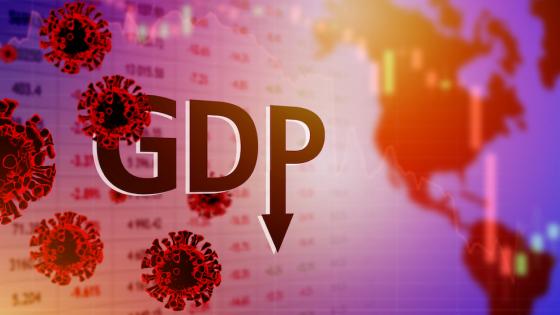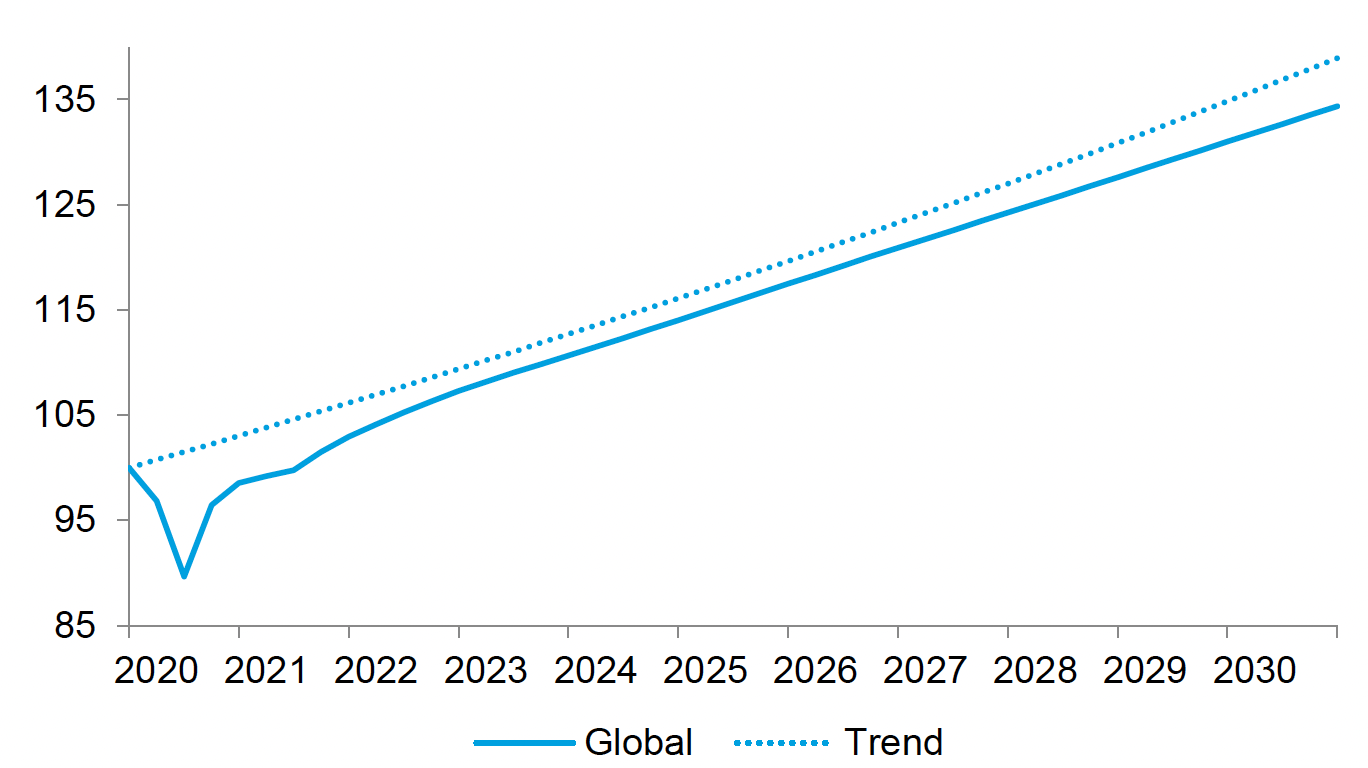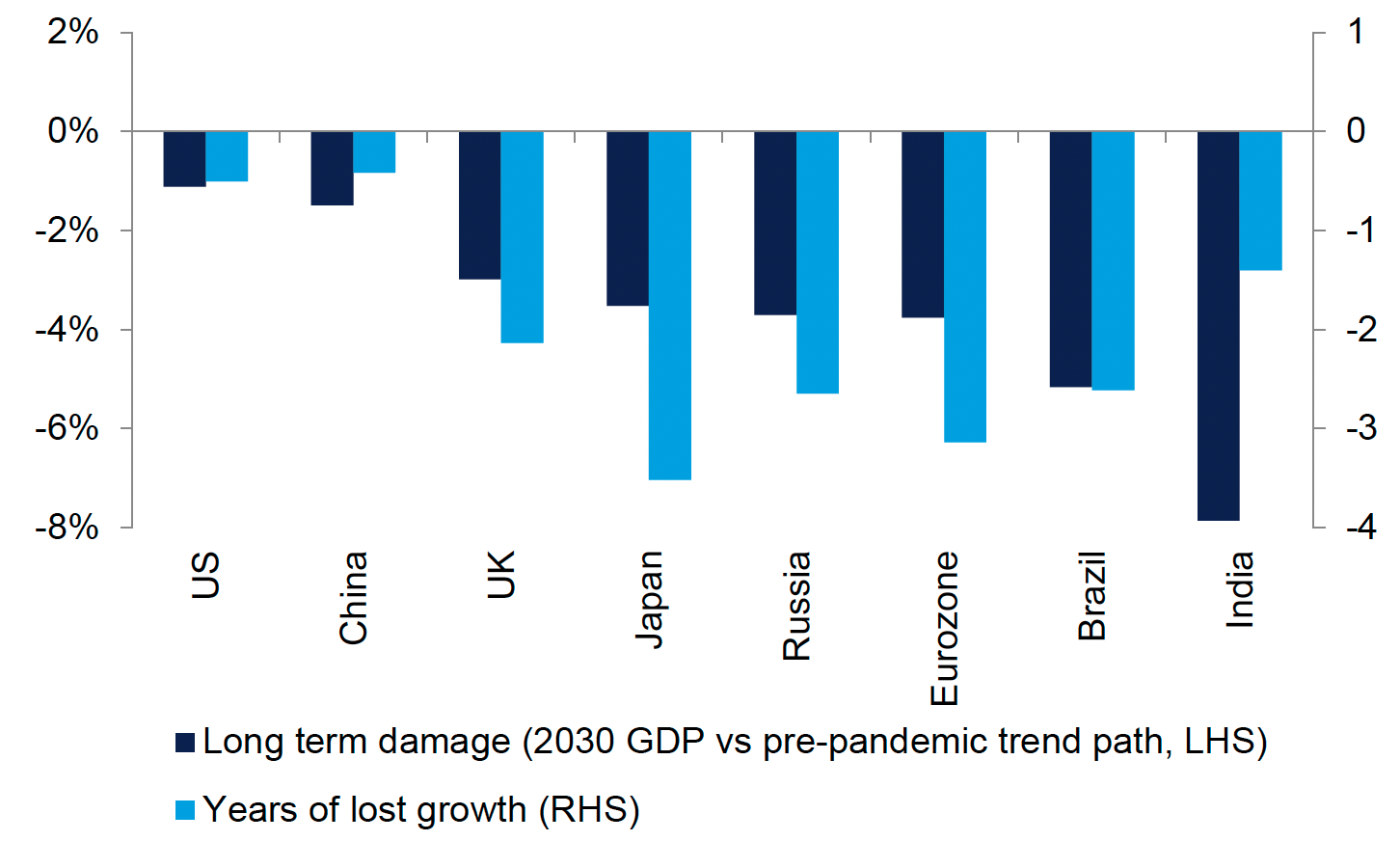As the global economy recovers from the immediate economic impact of the Covid crisis, attention is increasingly turning to the long-run impact of the shock on the productive potential of the economy. Such assessments are crucial in various looming policy choices. The UK government’s fiscal plans, for example, rest on the Office for Budget Responsibility’s assessment that the UK’s economic outlook will remain 3% below its pre-crisis trend into the long run (OBR 2021). And as the US Federal Reserve and other central banks begin to remove policy support, estimates of potential output and the output gap will be central to the assessment of inflation pressures.
While there is a growing literature studying the lasting impact that cyclical shocks can have on the supply side of the economy (Cerra et al. 2020), empirical work has tended to pick out financial crises as a source of shock with particularly lasting effects (Fuentes and Moder 2021). The Covid crisis is not a financial crisis, and past pandemics may not provide an especially helpful guide to the impact of Covid due to profound changes in the structure of the economy over time, and differences in the size and scope of pandemics (Bonam and Smădu 2021). There are therefore no ready analogues to consult when attempting to estimate the long run impact of this crisis.
In our recent work (Bartholomew and Diggle 2021), we approach the question by identifying the various channels through which this shock may cause lasting changes to the supply side of the economy, and assess how policy responses in various countries may have mitigated or exacerbated these channels.
A positive supply shock?
Recent data are consistent with an increase in aggregate productivity since the onset of the crisis, but it is hard to believe this reflects a persistent improvement in the supply side of the economy rather than a compositional effect that will reverse in time as economies continue to reopen.
There are, however, a number of channels through which Covid could have caused persistent improvements in productivity. Behavioural studies suggest that path dependencies can lock agents into sup-optimal behaviour, which large shocks can correct by forcing re-optimisation (Larcom et al. 2017). Covid may have caused such a re-optimisation – around working from home, for example – and may have accelerated the adoption, commercialisation, and diffusion of existing technologies to allow for shifting patterns of production and consumption.
It is also possible that the development of mRNA vaccines will kick-start a wave of other innovations in life science and medicine that boost total factor productivity.
However, we think these effects are unlikely to outweigh the various channels through which we expect Covid to have permanently depressed the supply side of the economy.
Labour market hysteresis and impaired skill acquisition
Economists have long understood that recessions can leave lasting scars on the labour market (Blanchard and Summers 1989). In particular, periods of unemployment are associated with skills erosion, loss of contact with the labour market, stigmatism, and a willingness to take unsuitable employment opportunities. All of these tend to weigh on labour supply and efficiency.
The impact of the initial Covid shock on labour markets around the world was mediated by differing labour market institutions in different economies. In the US, enhanced unemployment benefits allowed a surge in unemployment while supporting household incomes, whereas European furlough and short-time work schemes allowed a collapse in hours worked even as labour matches were largely maintained. These are in turn likely to mean quite different long run experiences: countries that experienced higher unemployment are more likely suffer from a lasting decline in labour force participation but may also enjoy a more efficient redeployment of labour.
The crisis is also likely to weigh more heavily on skill formation than standard recessions. The enormous number of education hours lost through school and university closures will have damaged human-capital accumulation (Burgess and Sievertsen 2020). While there is scope for catch-up learning among younger children, older children and adults on the cusp of entering the workplace may have permanently missed out on learning.
Indeed, it is well documented that downturns see a destruction of valuable firm-specific human capital (Fujita et al. 2020), and cohorts entering the labour market during a downturn tend to suffer lasting effects on their wages. The current cohort is particularly likely to struggle with building firm-specific human capital due to the weakness of the labour market combined with remote work making certain forms of firm-specific knowledge acquisition more difficult.
Belief scarring
The experience of a large negative shock can have a persistent impact on the beliefs of firms and businesses. Such ‘belief scarring’ can cause individuals to take systematically less risk in their household finance and portfolio allocation decisions (Malmendier and Nagel 2009) and may be associated with persistently higher desired saving and lower desired investment, resulting in permanent economic damage (Kozlowski et al. 2020).
Household saving rates have increased significantly since the start of the crisis, although it is not yet clear how persistent this increase will prove in light of changes to government balance sheets (Bilbiie et al. 2021). It is also plausible that in those countries with more extensive policy support, belief updating will see households and firms take a more expansive view of how much state-provided income support will be available in future downturns, and reduce their saving accordingly.
Zombification
The crisis may also see an increase in ‘zombie firms’ – unprofitable firms with low stock market valuation and difficulty servicing debts. There seems to be a ratchet effect on the quantity of such firms, with their number increasing during downturns, but little evidence that this process goes into reverse during recoveries (Banerjee and Hoffman 2018). The rise in such firms may weigh on productivity through congestion effects, impairing the reallocation of capital towards more productive uses.
Given the various emergency support schemes provided by governments during the Covid shock – including cutting interest rates and easing financial conditions more generally, emergency liquidity facilities, and regulatory forbearance – this crisis may have created many more zombie firms. For example, the German Economic Institute in Cologne estimated that an extra 4,300 zombie firms existed because of the German government’s relaxation of bankruptcy laws (Röhl 2020).
On the whole, government support probably stopped many more otherwise viable firms from going bust during the initial collapse in demand following the outbreak of the pandemic than it kept zombie firms going. However, as the economy recovers and re-orients to shifts in production and consumption habits, it is important that resources are allowed to re-allocate and that policies encourage rather than impede this process.
Policy error
The best way of ensuring this efficient reallocation of resources may be though expansive policy which tolerates periods of above-target inflation (Guerrieri et al. 2021). Indeed, we argue that insufficiently supportive demand-side policy is the biggest risk to the recovery from Covid and the mostly likely source of sustained damage to the supply side of the economy. Policy error of this kind was responsible for the sluggishness of economic growth following the financial crisis and it is easy to see similar mistakes being made again. There is also the risk that crisis fighting and economic weakness more generally leads to a reduction in impetus behind structural reform agendas, with trade liberalisation particularly vulnerable in this regard.
Quantifying the damage
Bringing this together, our central estimate is that Covid will impart a permanent levels shock to post-pandemic global economic output of 3% of GDP. This is a third the size of the levels damage after the global financial crisis. There are sizeable cross-country differences in the degree of long-term damage, depending on the severity of the viral experience, the size and design of policy responses, and the structure of labour markets. This means more long-term damage to the path of GDP in the euro area, India, and Brazil, and less in China and the US.
Figure 1 Path of global GDP
Figure 2 Long-term damage to level of GDP in 2025, relative to pre-pandemic trend path
Conclusion
These estimates are subject to very wide confidence intervals, not least because of the scope for policy to mitigate some of the channels we have identified. Indeed, the main takeaway of our analysis is the importance of pro-active demand and supply-side policies, ensuring a robust and rapid recovery in activity while allowing for any productivity-enhancing resource allocation to occur. We would stress investment in education catch-up, retraining schemes, infrastructure spending, demand management frameworks that require make-up of lost nominal activity, and a healthy competition regime.
References
Banerjee, R N and B Hofmann (2018), “The rise of zombie firms: causes and consequences”, BIS Quarterly Review.
Bilbiie, F, G Eggertsson and G Primiceri (2021), “US ‘Excess Savings’ are not excessive”, VoxEU.org, 01 March.
Blanchard, O and L Summers (1986), “Hysteresis and the European Unemployment Problem”, NBER Macroeconomics Annual 1986 1: 15-90.
Bonam, D and AI Smădu (2021), “The long-run effects of pandemics on inflation: Why this time may be different”, VoxEU.org, 18 July.
Burgess, S and H H Sievertsen (2020), “Schools, skills, and learning: The impact of COVID-19 on education”, VoxEU.org, 01 April.
Cerra, V, A Fatás and S C Saxena (2020), “The persistence of a COVID-induced global recession”, VoxEU.org, 14 May.
Diggle, P and L Bartholomew (2021), “Acute or Chronic? the Long-Term Impact of the COVID Crisis on Economic Output”, SSRN: 18 August.
Fuentes, N M and I Moder (2021), “The scarring effects of COVID-19 on the global economy”,VoxEU.org, 05 February.
Fujita, S, G Moscarini, F Postel-Vinay (2020), “The labour market policy response to COVID-19 must save aggregate matching capital”, VoxEU.org, 30 March.
Guerrieri, V, G Lorenzoni, L Straub and I Werning (2021), “Monetary Policy in Times of Structural Reallocation”, Kansas City Fed.
Kozlowski, J, L Veldkamp and V Venkateswaran (2020), “Scarring Body and Mind: The Long-Term Belief-Scarring Effects of Covid-19”, NBER Working Paper 27439.
Larcom, S, F Rauch and T Willems (2017), “The Benefits of Forced Experimentation: Striking Evidence from the London Underground Network”, The Quarterly Journal of Economics 132(4): 2019–2055.
Malmendier, U and S Nagel (2009), “Depression Babies: Do Macroeconomic Experiences Affect Risk-Taking?”, The Quarterly Journal of Economics 126(1): 373-416.
Office for Budget Responsibility (2021), “Economic and Fiscal Outlook – March 2021”.
Röhl, K (2020), “Insolvenzen: 4.300 Zombieunternehmen bis Jahresende”, Institut der deutschen Wirtschaft.





